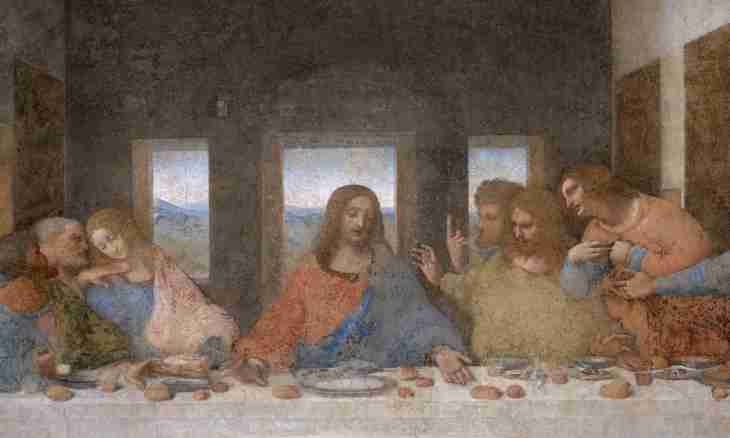"Last Supper" - one of the most known and massively the duplicated works by great Leonardo da Vinci. The fresco is written on a wall of the refectory Santa Maria church – della-Graziye in Milan. This church is a family tomb of the patron Leonardo, the duke Ludovic Sforts, and the picture was created by his order.
Leonardo's life
Leonardo da Vinci – one of the greatest geniuses ever living on the earth. The artist, the scientist, the writer, the engineer, the architect, the inventor and the humanist, the real person of Renaissance, Leonardo was born near the Italian town of Vinci, in 1452. Nearly 20 years (from 1482 to 1499) it "worked" for the duke Milan, Ludovic Sforts. "Last Supper" was written to this period of his life. Umer da Vinci in 1519 in France where it was invited by the king Francis I.
Innovation of composition
The plot of the picture "Last Supper" was used in painting more than once. According to the Gospel, during the last joint meal Jesus told "truly I say that one of you will betray me". Artists usually represented apostles at this moment gathered around a round or square table, but Leonardo wanted to show not only Jesus as the central figure, he wanted to represent reaction of all attendees to the Teacher's phrase. Therefore it selected the linear song allowing to represent everything characters full face or in a profile. In an iconography, traditional to Leonardo, it was also accepted to represent Jesus breaking bread with Judas and Ioann who clung to Christ's breast. Artists tried to emphasize with such composition the idea of treachery and atonement. Da Vinci broke also this canon.
In a traditional manner cloths with the image of the Last Supper of Giotto, Duccio and Sassett were written.
By the center of composition of Leonardo does Jesus Christ. The dominant position of Jesus is emphasized with the empty space around it, windows behind his back, objects before Christ are ordered whereas on a table before apostles the chaos reigns. Apostles are distributed by the artist on "three". Varfolomey, Jacob and Andrey sit at the left, Andrey threw up hands in the gesture meaning denial. Further Judas, Pyotr and Ioann follow. Judas's face is hidden in a shadow, in hands his linen bag. The femininity of a figure and the face of Ioann who fainted from news allowed numerous interpreters to assume that it is Mary Magdalene, but not the apostle. Foma, Jacob and Philip sit at Jesus, all of them are turned to Jesus and kind of expect from him explanations, the last group – Matfey, Faddei and Simone.
The plot of the work "Da Vinci Code" of Dan Brown in many respects is based on similarity of the apostle Ioann to the woman.
Legend of Judas
Precisely to write the emotions which captured apostles, Leonardo did not only numerous sketches, but also carefully selected models. The picture, 460 by 880 centimeters in size, was written within three years, from 1495 to 1498. The first wrote out Christ's figure for which, according to a legend, the young chorister with the spiritualized face posed. Judas had to be written to the last. Da Vinci long could not find the person whose person would bear the corresponding press of defect until good luck smiled to it and it, in one of prisons, met rather young, but fallen and by sight extremely corrupted person. After he stopped writing from him Judas, the model asked: - The master, really you do not remember me? A few years ago you wrote from me Christ for this fresco. Serious art critics disprove truthfulness of this legend.
Dry plaster and restorations
To Leonardo da Vinci all artists wrote frescos on wet plaster. It was important to manage to finish painting before it dries. As Leonardo wanted to write out carefully and laboriously the slightest details and also emotions of characters, he decided to write "Last Supper" on dry plaster. At first he covered a wall with a layer of pitch and mastic, then chalk and tempera. The method failed, though allowed the artist to work with extent of specification necessary to it. Did not pass also several decades as paint began to be showered. Serious damages wrote about the first in 1517. In 1556 the famous historian of painting Giorgio Vasari claimed that the fresco is hopelessly spoiled. In 1652 the picture was savagely damaged by the monks who did in the lower part on the center of a fresco a doorway. Only thanks to the copy of a picture made before by the unknown artist it is possible to see not only the initial details lost because of plaster destruction but also the destroyed part now. Since the 18th century numerous attempts to keep and restore the great work were made, but all of them did not do well to a picture. The striking example to that is a curtain which the fresco was closed in 1668. He forced to crowd on a wall moisture that led to the fact that paint became even more is shelled. In the 20th century to the aid of great creation all most modern achievements of science were given up. From 1978 to 1999 the picture was closed for viewing and the restorers trying to reduce as much as possible the loss caused by dirt, time, efforts of last "keepers" and to stabilize painting from further destruction worked on it. For this purpose the refectory was most sealed, in it the artificial environment is supported. Since 1999 to "Last Supper" let visitors, but only by appointment for the term of no more than 15 minutes.

